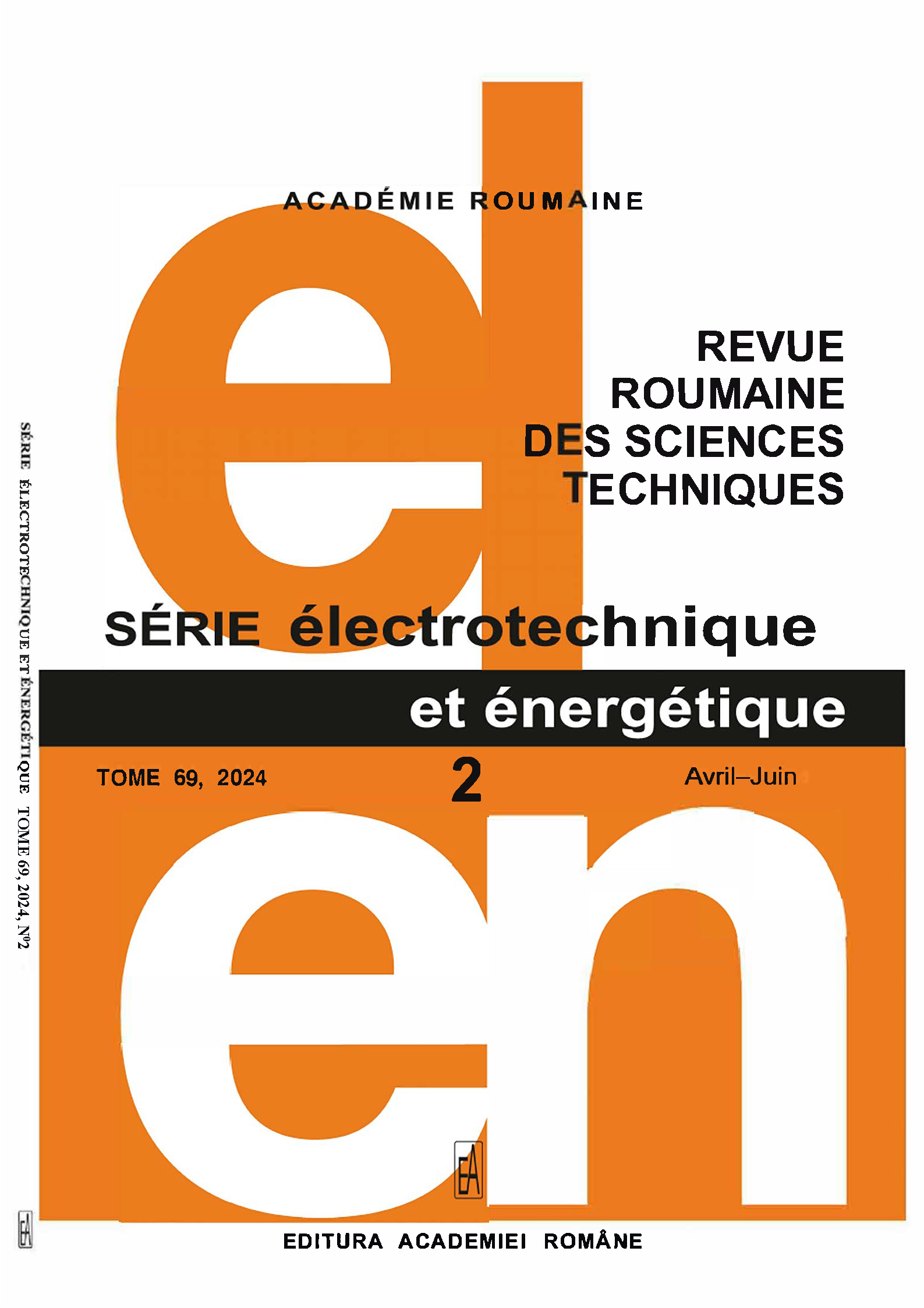ÉTUDE COMPARATIVE D'UNE MACHINE À AIMANT PERMANENT À INVERSION DE FLUX À ROTOR INTÉRIEUR ET EXTÉRIEUR POUR ÉOLIENNE À ENTRAÎNEMENT DIRECT
DOI :
https://doi.org/10.59277/RRST-EE.2024.2.1Mots-clés :
Machine d'inversion de flux, Rotor extérieur, Rotor intérieur, Entraînement direct, Éolienne, Optimisation des essaims de particules, Conception assistée par ordinateurRésumé
La topologie, le principe de fonctionnement et les performances électromagnétiques de la machine à aimant permanent d'inversion de flux du rotor interne (IRFRPM) et de la machine à aimant permanent d'inversion de flux du rotor externe (ORFRPM) sont comparés quantitativement dans cet article. Tout d’abord, le couple massique des deux machines est optimisé et comparé à l’aide de l’optimisation par essaim de particules (PSO) combinée à la méthode des éléments finis (FEM). Deuxièmement, les propriétés statiques des deux machines sont calculées à l’aide de l’analyse par éléments finis (FEA). Les deux machines conviennent aux éoliennes à entraînement direct, mais l'ORFRPM surpasse l'IRFRPM.
Références
(1) R.P. Deodhar, S. Andersson, I. Boldea T.J. Miller, The flux-reversal machine: A new brushless doubly-salient permanent-magnet machine. IEEE Transactions on Industry Applications, 33, 4, pp. 925–934 (1997).
(2) I. Boldea, J. Zhang, S.A. Nasar, Theoretical characterization of flux reversal machine in low-speed servo drives-the pole-PM configuration. IEEE Transactions on Industry Applications, 38, 6, pp. 1549–1557 (2002).
(3) T.H. Kim, J. Lee, A study of the design for the flux reversal machine. IEEE Transactions on Magnetics, 40, 4, pp. 2053–2055 (2004).
(4) I. Boldea, C. Wang, S.A. Nasar, Design of a three-phase flux reversal machine. Electric Machines &Power Systems, 27, 8, pp. 849–863 (1999).
(5) C. Wang, S. A. Nasar, I. Boldea, Three-phase flux reversal machine (FRM). IEE Proceedings-Electric Power Applications, 146, 2, pp. 139–146 (1999).
(6) D. S. More, B. G. Fernandes, Analysis of flux-reversal machine based on fictitious electrical gear, IEEE Transactions on Energy Conversion, 25, 4, pp. 940–947 (2010).
(7) C. X Wang, I. Boldea, S. A. Nasar, Characterization of three phase flux reversal machine as an automotive generator. IEEE Transactions on Energy Conversion, 16, 1, pp. 74–80 (2001).
(8) Y. Gao, D. Li, R. Qu, X. Fan, J. Li, H. Ding, A novel hybrid excitation flux reversal machine for electric vehicle propulsion. IEEE Transactions on Vehicular Technology, 67, 1, pp. 171–182 (2017).
(9) D. Li, Y. Gao, R. Qu, J. Li, Y. Huo, H. Ding, Design and analysis of a flux reversal machine with evenly distributed permanent magnets. IEEE Transactions on Industry Applications, 54, 1, pp. 172–183 (2017).
(10) R. Saou, M.E. Zaïm, K. Alitouche, Optimal Designs and Comparison of the Doubly Salient Permanent Magnet Machine and Flux-reversal Machine in Low-speed Applications, Electric Power Components and Systems, 36, 09, pp. 914–931 (2008).
(11) C. Guerroudj, R. Saou, A. Boulayoune, M.E. Zaïm, L. Moreau, Performance analysis of Vernier slotted doubly salient permanent magnet generator for wind power. International Journal of Hydrogen Energy, 42, 13, pp. 8744–8755 (2017).
(12) A. Boulayoune, C. Guerroudj, R. Saou, L. Moreau, M.E. Zaim, Optimisation par essaim de particule et algorithme génétique d’une machine à inversion de flux. Revue Roumaine des Sciences Techniques, Série Électrotechnique et Énergétique, 62, 1, pp. 19–24 (2017).
(13) J. Ojeda, M.G. Simões, G. Li, M. Gabsi. Design of a flux-switching electrical generator for wind turbine systems. IEEE Transactions on Industry Applications, 48, 6, pp.1808–1816 (2012).
(14) D.S. More, H. Kalluru, B.G. Fernandes, Outer rotor flux reversal machine for rooftop wind generator. In 2008 IEEE Industry Applications Society Annual Meeting, Edmonton, Alta, pp. 1–6, 2008.
(15) R. Eberhart, J. Kennedy, A new optimizer using particle swarm theory. In Proceedings of the Sixth International Symposium on Micro Machine and Human Science, 1, pp. 39–43. New York, NY, 1995.
(16) M. Clerc, J. Kennedy, The particle swarm — explosion, stability, and convergence in a multidimensional complex space. IEEE Transactions on Evolutionary Computation, 6, 1, pp. 58–73 (2002).
(17) P.J. Angeline. Using Selection to Improve Particle Swarm Optimization. IEEE International Conference on Evolutionary Computation Proceedings. IEEE World Congress on Computational Intelligence, 89, pp. 84–89 (1998).
(18) Y. Shi, R. Eberhart. A modified particle swarm optimizer. In Evolutionary Computation Proceedings, IEEE World Congress on Computational Intelligence., IEEE International Conference on, pap. 69–73 (1998).
(19) P.J. Lawrenson, J.M. Stephenson, P. Blenkinsop, J. Corda, N.N. Fulton, Variable-speed switched reluctance motors. In IEE Proceedings B-Electric Power Applications, 127, 4, pp. 253–265 (1980, July).
Téléchargements
Publiée
Numéro
Rubrique
Licence
(c) Copyright REVUE ROUMAINE DES SCIENCES TECHNIQUES — SÉRIE ÉLECTROTECHNIQUE ET ÉNERGÉTIQUE 2024

Ce travail est disponible sous licence Creative Commons Attribution - Pas d'Utilisation Commerciale - Pas de Modification 4.0 International.


